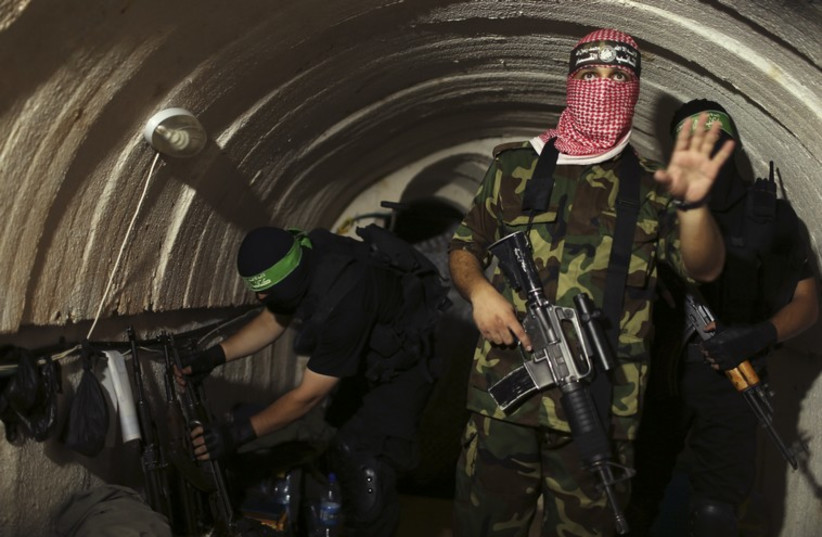IDF estimates published earlier this month claim that Hamas has lost 9,000 terrorists so far in this war. As of January 9, Hamas had also lost two brigade commanders, 19 battalion commanders, and 50 company commanders.
There is a saying that the “devil is in the details,” and when it comes to war, counting the number of people “eliminated” may be less helpful than it seems; there are several reasons for this.
One of the key issues is that Hamas will eventually recruit more terrorists to fill these ranks. It can’t easily recruit top terrorists, like battalion commanders, but it can fill lower ranks easily.
Measuring body counts in war is not unique to this one. Militaries like to measure things, especially in the modern era, where warfare is more complex and opaque. For example, Israel’s Momentum plan for war sought to make it more efficient and to close “sensor to shooter” loops more quickly.
What this means is that the sensor, such as a drone with a camera, sees a terrorist, and then an “effector,” or some kind of munition, is used to eliminate that terrorist. They are eliminated, and the number is recorded – one down. In a war in which artificial intelligence, big data, and “strike cells” play a role, measuring these numbers is a metric of accomplishment.

There is also obviously a good amount of controversy that comes with this type of measurement – body counts and declaring high numbers of enemies eliminated as a success – dating back to the Vietnam War, when the US used body counts as a measure of success.
This controversy, though, is not simple. “The humbling lesson we need to learn from the body count is not about picking the right metrics, but about the intrinsic, unavoidable limits of our tools for measuring and managing progress in war,” Jon Askonas, a DC-based fellow at the Foundation for American Innovation, wrote at War on the Rocks, an online platform for debate and analysis on foreign policy and national security through a Realist lens, in 2017.
Askonas notes that America’s top general in Vietnam was not necessarily wrong to use the body count metric, and the numbers weren’t necessarily inaccurate. He argues that the US was searching for a “crossover point” in an attrition strategy at the time: “The crossover point strategy relied on a basic equation: on one side, the number of soldiers the North Vietnamese could (or were willing to) recruit, train, and deploy into South Vietnam, on the other, the number the US military could kill, capture, or deter.” He concludes that “while there is a robust and growing literature on how to use metrics in counter-insurgency, you can’t get around the facts that showing progress in a variety of indicators does not amount to a strategy and that anytime you use an indicator as a target, you will damage its usefulness as an indicator.”
How to measure success?
Israel is fighting a complex war in Gaza. But the question remains, when do you call success and how do you measure it? During the 2012 Operation Pillar of Defense, the IDF claimed to have targeted 1,500 Hamas terrorist sites and eliminated 19 leaders of Hamas and Palestinian Islamic Jihad. In 2014, the IDF said it eliminated hundreds of terrorists in Gaza during Protective Edge.
Over the years, Hamas has taken losses, but it also continued to expand its arsenal and the number of men it has under arms. For instance, back in 2009, it had an estimated 20,000 armed men; when Hamas attacked Israel on October 7, it had around 30,000 armed men, according to estimates, organized into 24 battalions and 140 companies of men.
In essence, a Hamas “company” of men is supposed to have more than 215 men, fairly heavy companies in terms of a military organization. Hamas may have lost half its battalion commanders by December, while half its battalions had been broken down as well. The battalions are named after the areas in which they operate and are quite territorial units in that sense. The “Shati” battalion operated in Shati; it was later destroyed, and cannot be reconstituted in Shati. But, it can probably be reconstituted by recruiting among people who fled Shati to southern Gaza.
This is the question that now must bedevil Israeli policymakers regarding Gaza. With most of Gaza’s population now in the south – including more than a million people who fled the north during the fighting – Hamas now has a concentrated civilian population that can be preyed upon to serve its interests.
All Hamas has to do is recruit a small number of people – less than one percent – to fill up its ranks again. Hamas also has a lot of weapons to hand out to potential recruits, including AK-47s and RPGs.
Hamas may have lost most of its rocket arsenal, its “commando” units have been defeated or eliminated, and it may have lost battalion commanders and company commanders. But Hamas is also going to ground and seeking to fight a new kind of insurgency – so its need for heavy units, like a “company” of 200 men, is less relevant. It wants to use hit-and-run tactics, and it doesn’t need to train up new “battalions.”
If what Hamas wants is to recruit a few thousand more men, it likely has an easy resource in the fact that a million Gazans fled northern Gaza and are now sheltering in southern Gaza, where Hamas uses them as human shields.
The fact that the population that fled is composed mostly of women and children doesn’t prevent Hamas from recruiting from among the teenagers and young men that made up its ranks in the first place. Herein lies an issue with the numbers game, it’s not that the metrics are an issue, but that Hamas recruitment will be an issue as the war drags on into more and more months.
